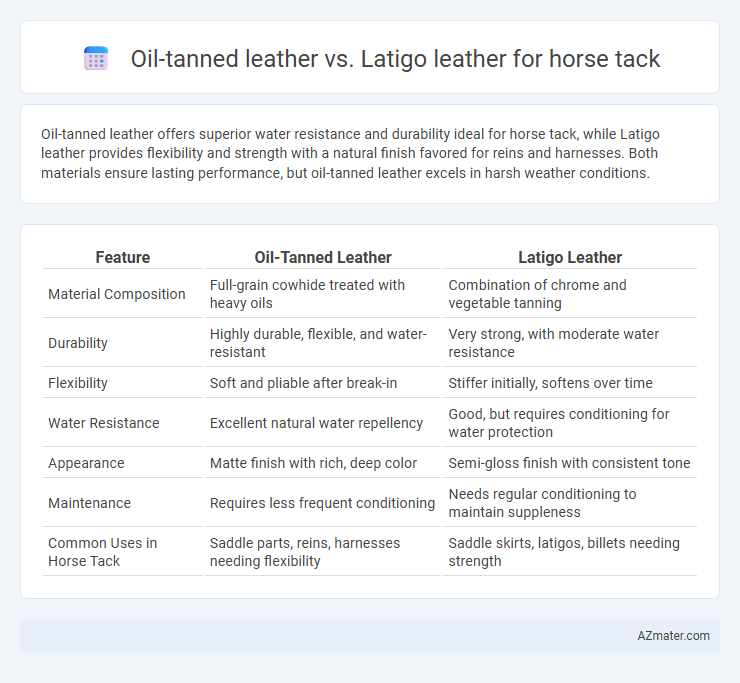Oil-tanned leather offers superior water resistance and durability ideal for horse tack, while Latigo leather provides flexibility and strength with a natural finish favored for reins and harnesses. Both materials ensure lasting performance, but oil-tanned leather excels in harsh weather conditions.
Table of Comparison
| Feature | Oil-Tanned Leather | Latigo Leather |
|---|---|---|
| Material Composition | Full-grain cowhide treated with heavy oils | Combination of chrome and vegetable tanning |
| Durability | Highly durable, flexible, and water-resistant | Very strong, with moderate water resistance |
| Flexibility | Soft and pliable after break-in | Stiffer initially, softens over time |
| Water Resistance | Excellent natural water repellency | Good, but requires conditioning for water protection |
| Appearance | Matte finish with rich, deep color | Semi-gloss finish with consistent tone |
| Maintenance | Requires less frequent conditioning | Needs regular conditioning to maintain suppleness |
| Common Uses in Horse Tack | Saddle parts, reins, harnesses needing flexibility | Saddle skirts, latigos, billets needing strength |
Introduction to Horse Tack Leather Types
Oil-tanned leather and Latigo leather are popular choices for horse tack due to their durability and performance. Oil-tanned leather undergoes a process involving natural oils that enhance softness, water resistance, and longevity, making it ideal for reins, girths, and harnesses. Latigo leather, known for its firmness and flexibility, results from a combination tanning method with chrome and vegetable tanning, offering strength and easy maintenance suitable for saddles and bridles.
What is Oil-Tanned Leather?
Oil-tanned leather is a type of leather treated by soaking it in oils and waxes to enhance durability, water resistance, and flexibility, making it ideal for horse tack exposed to harsh outdoor conditions. Unlike Latigo leather, which is chrome-tanned and finished with oils after tanning, oil-tanned leather undergoes tanning and oil treatment simultaneously, resulting in a natural, supple, yet sturdy texture that molds well to the horse and rider's shape. This leather's high-fat content prevents cracking and adds longevity, ensuring optimal performance and comfort in saddles, reins, and harnesses.
What is Latigo Leather?
Latigo leather is a durable, semi-flexible hide made from a combination of chrome and vegetable tanning, offering a balance between strength and pliability ideal for horse tack. Its robust, dense texture provides excellent resistance to stretching and moisture, making it well-suited for saddles and reins that require long-lasting performance. Compared to oil-tanned leather, which is softer and more supple due to heavy oil infusion, Latigo leather maintains a firmer hold and better shape retention under rigorous use.
Durability: Oil-Tanned vs Latigo Leather
Oil-tanned leather offers exceptional water resistance and flexibility due to its deep oil infusion, making it highly durable for horse tack exposed to wet conditions. Latigo leather combines the strength of chrome tanning with natural vegetable tanning, resulting in a sturdy, thick leather that resists stretching and tearing under heavy use. While oil-tanned leather provides superior softness and weather resistance, Latigo leather excels in structural integrity and longevity for saddles, bridles, and harnesses requiring firm support.
Water Resistance Comparison
Oil-tanned leather offers superior water resistance due to its deep oil infusion, which helps repel moisture and maintain flexibility even in wet conditions. Latigo leather, treated with a blend of oils and waxes, provides moderate water resistance but can absorb more moisture over time, potentially leading to stiffness or damage without regular conditioning. For horse tack exposed to variable weather, oil-tanned leather ensures longer-lasting durability and protection against water-related wear and tear.
Flexibility and Comfort for Horse Tack
Oil-tanned leather offers superior flexibility due to its deep conditioning process, making it ideal for horse tack that requires a soft and supple feel against the horse's skin. Latigo leather, known for its firmness and durability, provides a stiffer structure that molds over time but initially lacks the plush comfort of oil-tanned leather. For tack requiring immediate comfort and flexibility, oil-tanned leather is preferable, while Latigo excels in longevity and strength once broken in.
Maintenance and Care Requirements
Oil-tanned leather for horse tack requires regular conditioning with oil-based products to maintain suppleness and prevent drying or cracking, especially in dry climates. Latigo leather demands consistent cleaning and application of leather-specific conditioners to preserve its strength and flexibility, resisting water and sweat damage effectively. Both types benefit from proper storage away from excessive moisture and sunlight to extend their durability and performance in equestrian use.
Cost Differences and Value
Oil-tanned leather typically costs less than Latigo leather, making it a budget-friendly choice for horse tack without sacrificing durability. Latigo leather, known for its combination of chrome and vegetable tanning, offers enhanced flexibility and strength, translating to higher initial investment but greater longevity. When considering cost differences and overall value, Latigo leather provides superior wear resistance, which can reduce replacement frequency, whereas oil-tanned leather delivers solid performance at a lower upfront expense.
Best Uses for Oil-Tanned Leather in Tack
Oil-tanned leather offers superior water resistance and flexibility, making it ideal for outdoor horse tack such as saddles, halters, and bridles that require durability against weather exposure. Its soft texture and ability to retain oils provide enhanced comfort for the horse while resisting cracking and wear in high-stress areas. This leather is best used in tack components that benefit from longevity and ease of maintenance during heavy riding sessions and varied environmental conditions.
Best Uses for Latigo Leather in Tack
Latigo leather, known for its combination of durability and flexibility, is ideal for horse tack requiring strength and resistance to stretching, such as reins, cinches, and halters. Its oil-tanning process provides water resistance and a smooth finish, making it suitable for outdoor use and harsh weather conditions. Compared to oil-tanned leather, Latigo offers superior tensile strength and less break-in time, ensuring reliable performance in demanding equestrian activities.

Infographic: Oil-tanned leather vs Latigo leather for Horse tack
 azmater.com
azmater.com